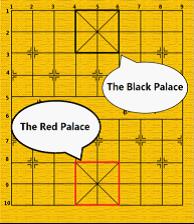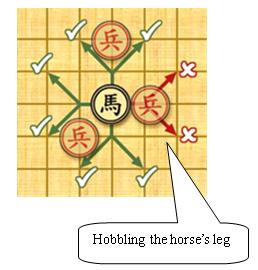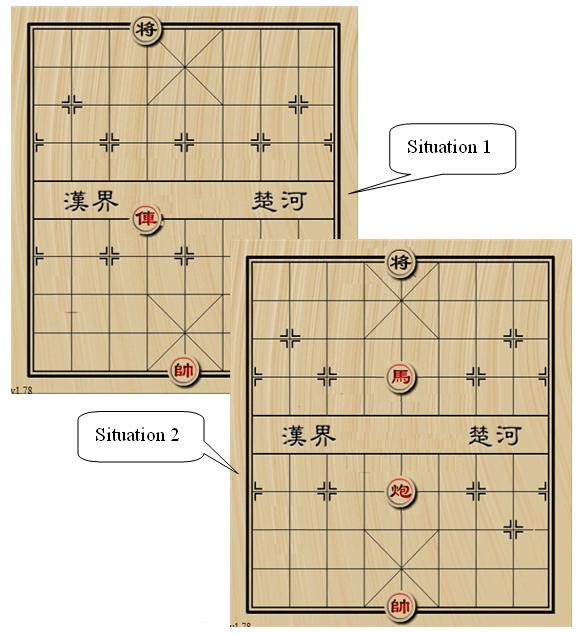UVA1589 Xiangqi
Xiangqi is one of the most popular two-player board games in China. The game represents a battle between two armies with the goal of capturing the enemy's ``general" piece. In this problem, you are given a situation of later stage in the game. Besides, the red side has already ``delivered a check". Your work is to check whether the situation is ``checkmate".
Now we introduce some basic rules of Xiangqi. Xiangqi is played on a 10 x 9 board and the pieces are placed on the intersections (points). The top left point is (1,1) and the bottom right point is (10,9). There are two groups of pieces marked by black or red Chinese characters, belonging to the two players separately. During the game, each player in turn moves one piece from the point it occupies to another point. No two pieces can occupy the same point at the same time. A piece can be moved onto a point occupied by an enemy piece, in which case the enemy piece is``captured" and removed from the board. When the general is in danger of being captured by the enemy player on the enemy player's next move, the enemy player is said to have ``delivered a check". If the general's player can make no move to prevent the general's capture by next enemy move, the situation is called ``checkmate".

We only use 4 kinds of pieces introducing as follows:

- General: the generals can move and capture one point either vertically or horizontally and cannot leave the `` palace" unless the situation called `` flying general" (see the figure above). ``Flying general" means that one general can ``fly" across the board to capture the enemy general if they stand on the same line without intervening pieces.

- Chariot: the chariots can move and capture vertically and horizontally by any distance, but may not jump over intervening pieces

- Cannon: the cannons move like the chariots, horizontally and vertically, but capture by jumping exactly one piece (whether it is friendly or enemy) over to its target.

- Horse: the horses have 8 kinds of jumps to move and capture shown in the left figure. However, if there is any pieces lying on a point away from the horse horizontally or vertically it cannot move or capture in that direction (see the figure below), which is called `` hobbling the horse's leg".

Now you are given a situation only containing a black general, a red general and several red chariots, cannons and horses, and the red side has delivered a check. Now it turns to black side's move. Your job is to determine that whether this situation is ``checkmate".
Input
The input contains no more than 40 test cases. For each test case, the first line contains three integers representing the number of red pieces N ( 2 N
N 7) and the position of the black general. The following N lines contain details of N red pieces. For each line, there are a char and two integers representing the type and position of the piece (type char `G' for general, `R' for chariot, `H' for horse and `C' for cannon). We guarantee that the situation is legal and the red side has delivered the check.
7) and the position of the black general. The following N lines contain details of N red pieces. For each line, there are a char and two integers representing the type and position of the piece (type char `G' for general, `R' for chariot, `H' for horse and `C' for cannon). We guarantee that the situation is legal and the red side has delivered the check.
There is a blank line between two test cases. The input ends by `0 0 0'.
Output
For each test case, if the situation is checkmate, output a single word ` YES', otherwise output the word ` NO'.
Hint: In the first situation, the black general is checked by chariot and ``flying general''. In the second situation, the black general can move to (1, 4) or (1, 6) to stop check. See the figure below.

Sample Input
2 1 4
G 10 5
R 6 4 3 1 5
H 4 5
G 10 5
C 7 5 0 0 0
Sample Output
YES
NO
看到这么个问题确实有点头疼,但是仔细想过之后不难用模拟来解决问题,附上代码(略长);
#include<stdio.h>
#include<string.h>
struct L
{
int a,b;
};
struct L General;
struct L Chariot[];
struct L Horse[];
struct L Cannon[];
int Qipan[][];
int n,x,y;
int tempx,tempy;
char type[];
int i1,i2,i3;
int mainflag;
int checkGenerals(int,int);
int checkChariot(int,int,int,int);
int checkHorse(int,int,int,int);
int checkCannon(int,int,int,int);
int checkPoint(int,int);
int main()
{
while(scanf("%d%d%d",&n,&x,&y)==&&n)
//Pay attention to the point (x,y),which is the black general located.
{
memset(Qipan,,sizeof(Qipan));
//Create a Qipan and define all of it are 0.
Qipan[x][y]=;
// When put some point on the broad,transfer it into 1.
//input the date,and store it into struct General,Chariot,Horse,Cannon.
i1=i2=i3=;
for(int i=;i<n;i++)
{
scanf("%s%d%d",type,&tempx,&tempy);
Qipan[tempx][tempy]=;
if(type[]=='G')
{
General.a=tempx;
General.b=tempy;
}
else if(type[]=='R')
{
Chariot[i1].a=tempx;
Chariot[i1++].b=tempy;
}
else if(type[]=='H')
{
Horse[i2].a=tempx;
Horse[i2++].b=tempy;
}
else if(type[]=='C')
{
Cannon[i3].a=tempx;
Cannon[i3++].b=tempy;
}
}
// Now it's high time to deal with the problem,with all of the dates are stored in order.
// The first we must check whether the two generals face to face directly.
if(checkGenerals(x,y))
{
printf("NO\n");
continue;
}
mainflag=;
if(x+<)
{
Qipan[x][y]=;
Qipan[x+][y]++;
if(checkPoint(x+,y))
mainflag=;
Qipan[x][y]=;
Qipan[x+][y]--;
}
if(mainflag)
{
printf("NO\n");
continue;
}
if(x->)
{
Qipan[x][y]=;
Qipan[x-][y]++;
if(checkPoint(x-,y))
mainflag=;
Qipan[x][y]=;
Qipan[x-][y]--;
}
if(mainflag)
{
printf("NO\n");
continue;
}
if(y+<)
{
Qipan[x][y]=;
Qipan[x][y+]++;
if(checkPoint(x,y+))
mainflag=;
Qipan[x][y]=;
Qipan[x][y+]--;
}
if(mainflag)
{
printf("NO\n");
continue;
}
if(y->)
{
Qipan[x][y]=;
Qipan[x][y-]++;
if(checkPoint(x,y-))
mainflag=;
Qipan[x][y]=;
Qipan[x][y-]++;
}
if(mainflag)
{
printf("NO\n");
continue;
}
printf("YES\n");
}
}
int checkGenerals(int x,int y)
{
if(General.b==y)
{
int Flag=;
for(int i=x+;i<General.a;i++)
if(Qipan[i][y])
Flag++;
if(Flag==)
return ;
}
return ;
}
int checkChariot(int x1,int y1,int x2,int y2)
{
int Flag;
int xj1,yj1,xj2,yj2;
xj1=x1<x2?x1:x2;
xj2=x1>x2?x1:x2;
yj1=y1<y2?y1:y2;
yj2=y1>y2?y1:y2;
if(x1==x2&&y1==y2)
return ;
if(x1==x2)
{
Flag=;
for(int j=yj1+;j<yj2;j++)
if(Qipan[x1][j])
Flag=;
if(Flag==) return ;
}
if(y1==y2)
{
Flag=;
for(int i=xj1+;i<xj2;i++)
if(Qipan[i][y1])
Flag=;
if(Flag==) return ;
}
return ;
}
int checkHorse(int x1,int y1,int x2,int y2)
{
if(x1+==x2&&y1+==y2)
if(Qipan[x1][y1+]==)
return ;
if(x1+==x2&&y1-==y2)
if(Qipan[x1][y1-]==)
return ;
if(x1-==x2&&y1+==y2)
if(Qipan[x1][y1+]==)
return ;
if(x1-==x2&&y1-==y2)
if(Qipan[x1][y1-]==)
return ;
if(x1+==x2&&y1+==y2)
if(Qipan[x1+][y1]==)
return ;
if(x1+==x2&&y1-==y2)
if(Qipan[x1+][y1]==)
return ;
if(x1-==x2&&y1+==y2)
if(Qipan[x1-][y1]==)
return ;
if(x1-==x2&&y1-==y2)
if(Qipan[x1-][y1]==)
return ;
return ;
}
int checkCannon(int x1,int y1,int x2,int y2)
{
int Flag=;
int xj1,yj1,xj2,yj2;
xj1=x1<x2?x1:x2;
xj2=x1>x2?x1:x2;
yj1=y1<y2?y1:y2;
yj2=y1>y2?y1:y2;
if(x1==x2&&y1==y2) return ;
if(x1==x2)
{
for(int j=yj1+;j<yj2;j++)
if(Qipan[x1][j]) Flag++;
if(Flag==) return ;
}
if(y1==y2)
{
for(int i=xj1+;i<xj2;i++)
if(Qipan[i][y1]) Flag++;
if(Flag==) return ;
}
return ;
}
int checkPoint(int x,int y)
{
if(checkGenerals(x,y))
return ;
for(int i=;i<i1;i++)
if(checkChariot(Chariot[i].a,Chariot[i].b,x,y))
return ;
for(int i=;i<i2;i++)
if(checkHorse(Horse[i].a,Horse[i].b,x,y))
return ;
for(int i=;i<i3;i++)
{
if(checkCannon(Cannon[i].a,Cannon[i].b,x,y))
return ;
}
return ;
}
UVA1589 Xiangqi的更多相关文章
- [刷题]算法竞赛入门经典(第2版) 4-1/UVa1589 - Xiangqi
书上具体所有题目:http://pan.baidu.com/s/1hssH0KO 代码:(Accepted,0 ms) //UVa1589 #include<iostream> #incl ...
- UVA1589——xiangqi
开始碰到这个题时觉得太麻烦了直接跳过没做,现在放假了再次看这个题发现没有想象中那么麻烦,主要是题目理解要透彻,基本思路就是用结构体数组存下红方棋子,让黑将军每次移动一下,看移动后是否有一个红方棋子可以 ...
- 【习题4-1 Uva1589】Xiangqi
[链接] 我是链接,点我呀:) [题意] 在这里输入题意 [题解] 车是可以被吃掉的... 注意这个情况. 其他的模拟即可. [代码] #include <bits/stdc++.h> u ...
- HDU 4121 Xiangqi 我老了?
Xiangqi Time Limit: 2000/1000 MS (Java/Others) Memory Limit: 32768/32768 K (Java/Others)Total Sub ...
- HDU 4121 Xiangqi 模拟题
Xiangqi Time Limit: 20 Sec Memory Limit: 256 MB 题目连接 http://acm.hdu.edu.cn/showproblem.php?pid=4121 ...
- Uva - 1589 - Xiangqi
Xiangqi is one of the most popular two-player board games in China. The game represents a battle bet ...
- [算法竞赛入门经典] 象棋 ACM/ICPC Fuzhou 2011, UVa1589 较详细注释
Description: Xiangqi is one of the most popular two-player board games in China. The game represents ...
- Xiangqi(简单模拟)
4746: Xiangqi 时间限制(普通/Java):1000MS/3000MS 内存限制:65536KByte 总提交: 15 测试通过:2 描述 Xiangqi i ...
- TZOJ 4746 Xiangqi(模拟棋盘数组)
描述 Xiangqi is one of the most popular two-player board games in China. The game represents a battle ...
随机推荐
- iOS触摸事件深度解析-备用
概述 本文主要解析从我们的手指触摸苹果设备到最终响应事件的整个处理机制.本质上讲,整个过程可以分为两个步骤: 步骤1:找目标.在iOS视图层次结构中找到触摸事件的最终接受者: 步骤2:事件响应.基于i ...
- NGINX当中的SSL配置(PEM启动密码免输入)
干过的都懂,这个东东好像很碍事. 很影响RELOAD的效率...并且,,,好像这个弄了之后,NGINX作RELOAD之后,可以即时更新配置了..(还是说那个DVROOT.CER影响的??未考证) ht ...
- LeetCode_Partition List
Given a linked list and a value x, partition it such that all nodes less than x come before nodes gr ...
- Cmake的install与file命令的区别
实际上他们两个可以达到一个目标(对于文件操作),但是又有本质上的区别,文档没有细看,但是一般利于项目的管理,使用install,install命令如果在cmake命令中没有指名install参数,实际 ...
- mv command:unable to remove target: Is a director
mv command:unable to remove target: Is a director This is somewhat simple as long as we understand t ...
- 使IE6同样支持圆角效果
之前写到过,IE6不支持:hover效果的解决办法,其它这个跟它一样.IE6(7/8)不支持border-radius属性,所以其中的圆角效果显示不出来,可以通过引用ie-css3.htc的方法解决. ...
- java基础进阶:SQL的运用
SQL的基础的运用 /* --1.学生表 Student(S,Sname,Sage,Ssex) --S 学生编号,Sname 学生姓名,Sage 出生年月,Ssex 学生性别 --2.课程表 Cour ...
- windows对象总结
这篇文章是对windows对象的总结,在winows编程中,windows对象,句柄是一个基本概念,理解这些概念有助于后面的windows编程学习.文章的形式还是以解答问题的方式来组织. 注:在文中, ...
- 法爱格2014 春夏新款欧美纯色修身高腰无袖吊带V领 拼接性感 连衣裙 黑色 M【图片 价格 品牌 报价】-京东
法爱格2014 春夏新款欧美纯色修身高腰无袖吊带V领 拼接性感 连衣裙 黑色 M[图片 价格 品牌 报价]-京东 法爱格2014 春夏新款欧美纯色修身高腰无袖吊带V领 拼接性感 连衣裙 黑色 M
- Java集合的实现细节—Set集合和Map集合
Set:代表无序.不可重复的集合 Map:代表key-value对集合,也称为关联数组 从表面上看,Set和Map相似性很少,但实际上可以说Map集合时Set集合的扩展. 1.Set集合和Map集合的 ...
